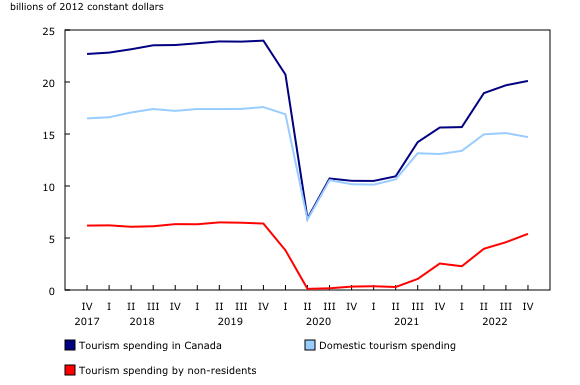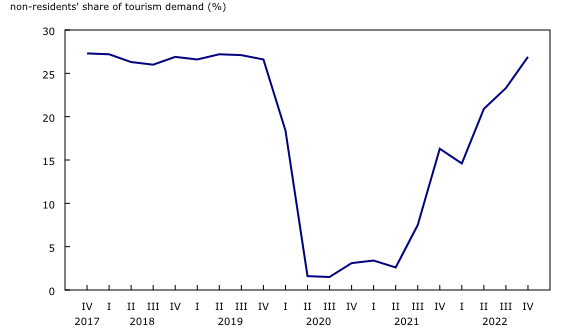National tourism indicators, fourth quarter 2022
Released: 2023-03-30
Tourism spending in Canada grew 2.1% in the fourth quarter, the seventh consecutive quarterly increase. Tourism gross domestic product (GDP) (+2.1%) and jobs attributable to tourism (+1.5%) also rose in the fourth quarter.
Despite the tourism sector's continued recovery in the fourth quarter, tourism spending was 16.2% lower than the pre-COVID-19 pandemic levels from the fourth quarter of 2019. By comparison, in the fourth quarter of 2021, tourism spending was 34.8% lower than pre-pandemic levels. Over 2022, this gap narrowed sharply as tourism spending in Canada increased 45.1%, fuelled by a tripling of outlays on passenger air transport compared with 2021.
Passenger air transport (+4.6%) contributed the most to the growth in tourism spending in the fourth quarter, followed by recreation and entertainment (+6.7%) and non-tourism products (+2.0%).
Tourism GDP grew 2.1% in the fourth quarter, after increasing 4.5% in the third quarter. Growth was mostly driven by transportation services (+8.5%). Overall, tourism GDP was 82.7% of its pre-pandemic level, while tourism's share of GDP edged up to 1.58% in the fourth quarter.
Employment attributable to tourism rose 1.5% in the fourth quarter, following gains of 3.9% in the third quarter. Recreation and entertainment (+4.9%), food and beverage services (+0.9%) and accommodation (+1.1%) industries were the largest contributors to the growth. Tourism's share of employment edged up to 3.27%.
Annually, tourism GDP increased 43.1%, while jobs attributable to tourism demand rose 22.1%.
Tourism spending by international visitors increases
Tourism spending by international visitors rose 17.5% in the fourth quarter after increasing 15.9% in the previous quarter. Accommodation (+17.8%) was the largest contributor to the quarter's growth.
International visitors accounted for 26.9% of tourism spending in Canada in the fourth quarter, compared with 23.3% in the previous quarter. Tourism spending by international visitors was 15.5% lower than pre-pandemic levels.
Annually, spending by international visitors increased 281.0% and represented 21.8% of tourism spending in Canada in 2022.
Tourism spending in Canada by Canadians decreases
Tourism spending in Canada by Canadians declined 2.6% in the fourth quarter, following a 0.8% increase in the previous quarter. Lower outlays on accommodation (-9.3%), non-tourism products (-5.5%) and food and beverage services (-3.7%) all contributed to the decline.
The overall decline coincides with an increase in the number of Canadians travelling abroad.
Annually, tourism spending in Canada by Canadians rose 23.7%, with passenger air transport (+191.4%) largely contributing to the increase.
Sustainable development goals
On January 1, 2016, the world officially began implementing the 2030 Agenda for Sustainable Development, the United Nations' transformative plan of action that addresses urgent global challenges over the next 15 years. The plan is based on 17 specific sustainable development goals.
The national tourism indicators are an example of how Statistics Canada supports the reporting on the global goals for sustainable development. This release will be used in helping to measure the following goal:

Note to readers
With the fourth quarter of 2022 release of the national tourism indicators, all data are benchmarked to the 2019 Provincial and Territorial Tourism Satellite Account. As a result, all previously published data have been updated.
Growth rates for tourism spending and gross domestic product (GDP) are expressed in real terms (that is, adjusted for price changes), using the 2012 reference year, as well as adjusted for seasonal variations, unless otherwise indicated.
Employment data are also seasonally adjusted.
Tourism's share of economy-wide GDP is calculated from seasonally adjusted nominal values.
Tourism's share of economy-wide employment is calculated using seasonally adjusted values.
For information on seasonal adjustment, see Seasonally adjusted data – Frequently asked questions.
Associated percentage changes are presented at quarterly rates unless otherwise noted.
Non-tourism industries, also referred to as other industries, are industries that would continue to exist in the absence of tourism. For example, the crop production and petroleum refineries industries produce products purchased by tourists. However, neither would cease to exist in the absence of tourism. Tourism GDP takes into account the production of these products purchased by tourists.
Non-tourism products, also referred to as other products, are products for which a significant part of its total demand in Canada does not come from visitors, such as groceries, clothing and alcohol bought in stores.
Revisions over the 2020-to-2022 period are expected to be higher than normal due to the volatile economic situation, particularly for the tourism sector.
The national tourism indicators are funded by Destination Canada.
Next release
Data on the national tourism indicators for the first quarter of 2023 will be released on June 29, 2023.
Products
The Economic accounts statistics portal, accessible from the Subjects module of the Statistics Canada website, features an up-to-date portrait of national and provincial economies and their structure.
The Latest Developments in the Canadian Economic Accounts (13-605-X) is available.
The User Guide: Canadian System of Macroeconomic Accounts (13-606-G) is available.
The Methodological Guide: Canadian System of Macroeconomic Accounts (13-607-X) is available.
Contact information
For more information, or to enquire about the concepts, methods or data quality of this release, contact us (toll-free 1-800-263-1136; 514-283-8300; infostats@statcan.gc.ca) or Media Relations (statcan.mediahotline-ligneinfomedias.statcan@statcan.gc.ca).
- Date modified:





